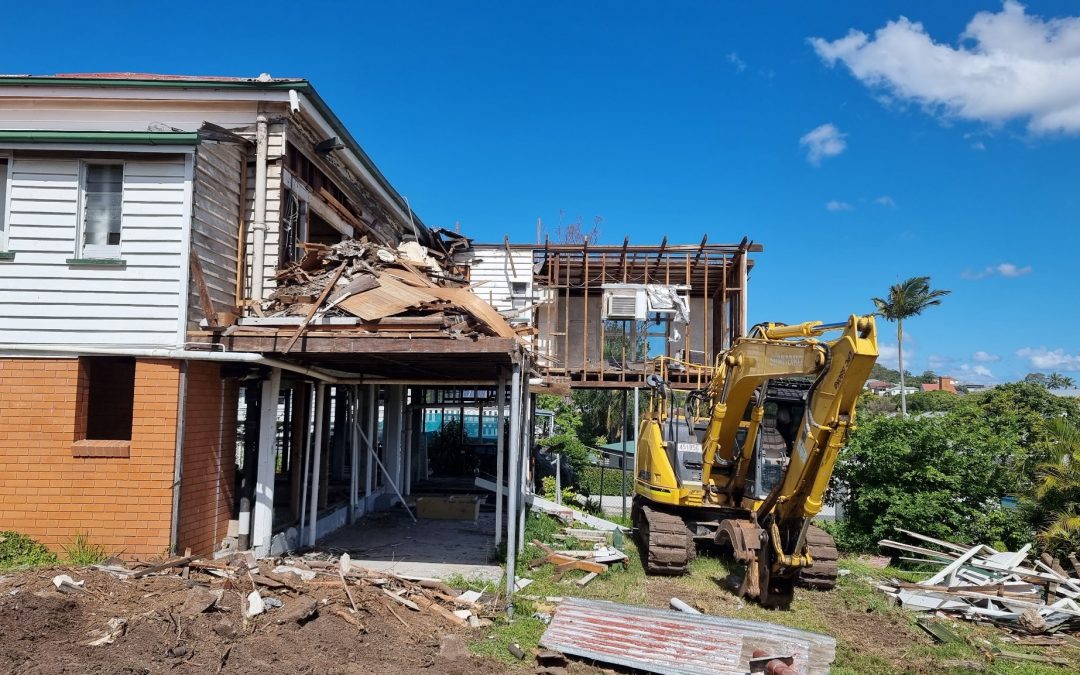Demolition specialists understand that when most people hear “demolition,” they envision brute force and chaos. However, aside from demolition, it often goes unnoticed—the artistry of traditional demolition. In this blog, we’ll take you on a journey to explore the craftsmanship, skill, and creativity thus making traditional demolition a form of deconstruction by design.
The Artistry of Traditional Demolition
Traditional demolition is far from a wrecking ball swinging wildly through a building. In fact it’s an art form that systematically deconstructs structures, revealing their inner architectural beauty. This approach allows for carefully preserving and repurposing materials, breathing new life into what was once considered obsolete.
Demolition as Deconstruction
Think of traditional demolition as a form of deconstruction. Skilled artisans approach each project with the mindset of uncovering hidden gems within a structure. In fact it’s not just about tearing down; it’s about revealing the essence of a building’s design and history.
The Role of Skilled Artisans
At the heart of traditional demolition is a team of skilled artisans. Certainly these demolition specialists are craftsmen have unique skills that enable them to dismantle buildings like fine art pieces. They treat each brick, beam, and panel as art, carefully preserving what can be reused or repurposed.
Safety as a Priority
While traditional demolition embraces artistry, safety is always a top priority, we follow Safework Australia. Artisans adhere to rigorous safety protocols, donning protective gear and following established procedures. The artistry lies in finding the delicate balance between deconstruction and safety.
Environmental Responsibility and Sustainability
Traditional demolition has a sustainable side, too. Artisans engage in recycling and upcycling practices, minimising waste and reducing the environmental impact. Materials once considered debris find new life in other projects, contributing to a more sustainable construction industry.
Examples of Demolition Artistry
Let’s look at real-world examples to appreciate demolition as an art form. Consider an old warehouse with intricate metalwork or a historic theatre with ornate plaster ceilings. Traditional demolition artisans are demolition specialists and have carefully dismantled these structures, revealing their architectural splendour for future generations.
The Craftsmanship in Action
The process of traditional demolition is a meticulous one. Artisans systematically dismantle a building, preserving architectural elements and materials that tell a story of the past. It’s an artistic expression that uncovers the hidden beauty within the layers of construction.
Reviving Architectural Elements
One of the most exciting aspects of traditional demolition artistry is the revival of architectural elements. Ornate columns, vintage light fixtures, and unique tiles are often salvaged and repurposed in new construction projects. It preserves history and adds character and authenticity to modern spaces.
The Future of Demolition Artistry
As we look to the future, traditional demolition artistry is poised for innovation. Technology and creativity intersect to enhance the deconstruction process further. While the artistry remains, modern construction practices are integrated to meet the evolving needs of the industry.
Conclusion – The Demolition Specialists
In construction, there’s more to demolition than meets the eye. Traditional demolition is an art form, a careful and deliberate deconstruction that reveals the beauty within aging structures. It’s a testament to the craftsmanship and creativity of those who see beyond destruction and into the design world.
Suppose you’re intrigued by the artistry of traditional demolition or have a project that requires skilled artisans. In that case, we invite you to explore this fascinating world further. Contact Powertrak your demolition specialists today to learn more about how we can bring creativity and craftsmanship to your demolition project.
Areas we service.
Brisbane, Northern Gold Coast and Ipswich
Suburbs we service include:
Inner Suburbs
Bowen Hills – Brisbane CBD – East Brisbane – Fortitude Valley – Herston – Highgate Hill – Kangaroo Point – Kelvin Grove – New Farm – Newstead – Paddington – Petrie Terrace – Red Hill – South Brisbane – Spring Hill – Teneriffe – West End – Woolloongabba
Northern Suburbs
Albion – Alderley – Ascot – Aspley – Bald Hills – Banyo – Boondall – Bracken Ridge – Bridgeman Downs – Brighton – Brisbane Airport – Carseldine – Chermside – Chermside West – Clayfield – Deagon – Eagle Farm – Everton Park – Ferny Grove – Fitzgibbon – Gaythorne – Geebung – Gordon Park – Grange – Hamilton – Hendra – Kalinga – Kedron – Keperra – Lutwyche – McDowall – Mitchelton – Myrtletown – Newmarket – Northgate – Nudgee – Nudgee Beach – Nundah – Pinkenba – Sandgate – Shorncliffe – Stafford – Stafford Heights – Taigum – Virginia – Wavell Heights – Wilston – Windsor – Wooloowin – Zillmere
Southern Suburbs
Acacia Ridge – Algester – Annerley – Archerfield – Burbank – Calamvale – Coopers Plains – Darra – Doolandella – Drewvale – Durack – Dutton Park – Eight Mile Plains – Ellen Grove – Fairfield – Forest Lake – Greenslopes – Heathwood – Holland Park – Holland Park West – Inala – Karawatha – Kuraby – Larapinta – MacGregor – Mackenzie – Mansfield – Moorooka – Mount Gravatt – Mount Gravatt East – Nathan – Pallara – Parkinson – Richlands – Robertson – Rochedale – Rocklea – Runcorn – Salisbury – Seventeen Mile Rocks – Sinnamon Park – Stones Corner – Stretton – Sumner – Sunnybank – Sunnybank Hills – Tarragindi – Tennyson – Upper Mount Gravatt – Wacol – Willawong – Wishart – Yeerongpilly – YerongaEastern Suburbs
Eastern Suburbs
Balmoral – Belmont – Bulimba – Camp Hill – Cannon Hill – Carina – Carina Heights – Carindale – Chandler – Coorparoo – Gumdale – Hawthorne – Hemmant – Lota – Lytton – Manly – Manly West – Moreton Island – Morningside – Murarrie – Norman Park – Port of Brisbane – Ransome – Seven Hills – Tingalpa – Wakerley – Wynnum – Wynnum West
Western Suburbs
Anstead – Ashgrove – Auchenflower – Banks Creek– Bardon – Bellbowrie – Brookfield – Chapel Hill – Chelmer – Chuwar – Corinda – England Creek– Enoggera – Enoggera Reservoir – Fig Tree Pocket – Graceville – Indooroopilly – Jamboree Heights – Jindalee – Karana Downs – Kenmore – Kenmore Hills – Kholo – Lake Manchester – Middle Park – Milton – Moggill – Mount Coot-tha – Mount Crosby – Mount Ommaney – Oxley – Pinjarra Hills – Pullenvale – Riverhills – Seventeen Mile Rocks – Sherwood – Sinnamon Park – St Lucia – Taringa – The Gap – Toowong – Upper Brookfield – Upper Kedron – Westlake




Recent Comments